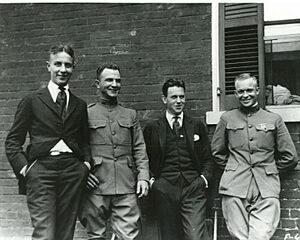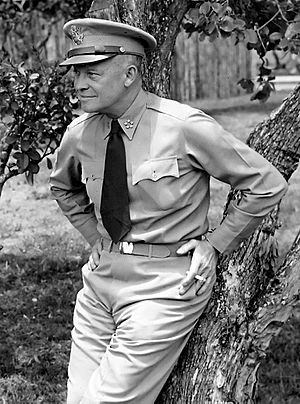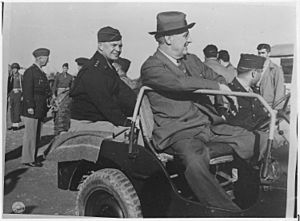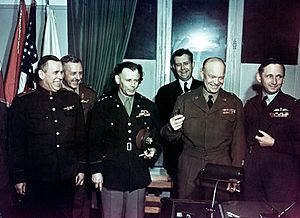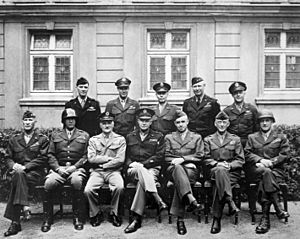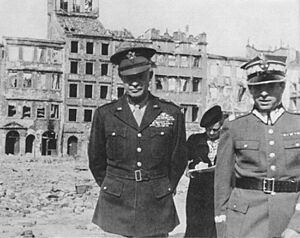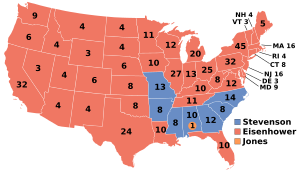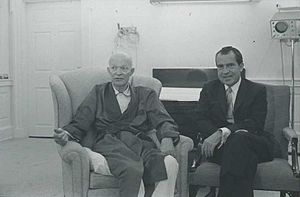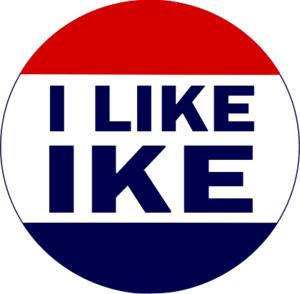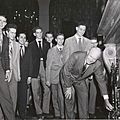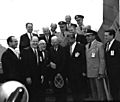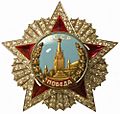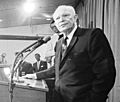Dwight D. Eisenhower facts for kids
Quick facts for kids
Dwight David Eisenhower
|
|
|---|---|
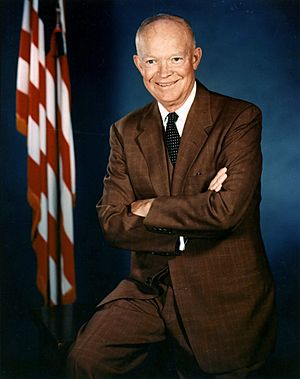 |
|
| 34th President of the United States | |
| In office January 20, 1953 – January 20, 1961 |
|
| Vice President | Richard Nixon |
| Preceded by | Harry S. Truman |
| Succeeded by | John F. Kennedy |
| Personal details | |
| Born | October 14, 1890 Denison, Texas |
| Died | March 28, 1969 (aged 78) Washington, D.C. |
| Nationality | American |
| Political party | Republican |
| Spouse | Mamie Doud Eisenhower |
| Children | Doud, John |
Dwight David "Ike" Eisenhower (born October 14, 1890 – died March 28, 1969) was the 34th President of the United States. He served as president from 1953 to 1961. Before becoming president, he was a famous general. He helped lead the Allied forces to victory in World War II.
Contents
Early Life and Education
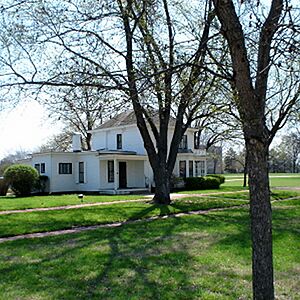
Dwight D. Eisenhower's family came from Germany. They moved to North America in 1741. Later, in the 1880s, they settled in Kansas. Dwight's father, David Jacob Eisenhower, married Ida Elizabeth Stover in 1885.
Dwight D. Eisenhower was born on October 14, 1890, in Denison, Texas. He was the third of seven boys. His mother first named him David Dwight. But she changed it to Dwight David to avoid having two Davids in the family. All the boys were called "Ike." Dwight was known as "Little Ike."
In 1892, his family moved to Abilene, Kansas. Dwight always thought of Abilene as his true hometown. His mother did not like war, but she had many history books. "Little Ike" loved reading these books. He learned a lot about military history.
His parents made sure the family read the Bible together every day. They also gave chores to all the children. Everyone had to help around the house.
Dwight went to Abilene High School. In his first year, he hurt his knee badly. The doctor wanted to remove his leg, but Dwight refused. He got better, which was amazing. He had to repeat his first year and finished school in 1909.
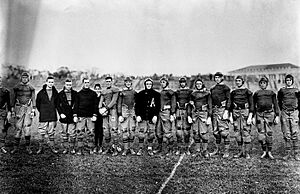
Dwight and his brother Edgar both wanted to go to college. But they did not have enough money. They agreed to take turns going to college. One would work to earn money while the other studied.
Edgar went first and asked for a second year, which Dwight allowed. In 1911, Dwight got a chance to go to West Point. This is a famous military school. English was his best subject. He played football and was a cheerleader. He finished in the middle of his class in 1915. Many members of his class later became important generals.
Personal Life
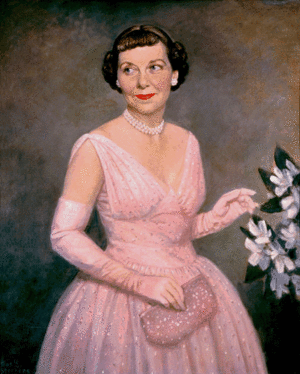
While stationed in Texas, Eisenhower met Mamie Doud. He asked her to marry him on Valentine's Day in 1916. They planned to marry in November. But because the U.S. entered World War I, they married earlier, on July 1.
The Eisenhowers had two sons. Their first son, Doud Dwight "Icky" Eisenhower, died at age three from scarlet fever. Their second son, John Eisenhower, was born in Denver, Colorado. John later married Barbara Jean Thompson. They had four children: David, Barbara Ann, Susan Elaine, and Mary Jean. Camp David, a famous presidential retreat, is named after their grandson, David.
Eisenhower was very good at card games. He had a great memory and could focus well. He learned to play poker in Abilene. He called it his "favorite indoor sport." He also learned contract bridge at West Point. He played bridge throughout his military career. People even called him "the bridge wizard of Manila." He was a skilled player and always fair.
Later in life, Eisenhower loved to play golf. He played as often as he could. In winter, he had his golf balls painted black. This helped him see them better against the snow.
Oil painting was another hobby of Eisenhower's. He painted about 260 oil paintings in his last 20 years. He painted to relax. Most of his paintings were landscapes. But he also painted portraits of people like Mamie, his grandchildren, and famous figures like George Washington and Abraham Lincoln.
Military Career
World War I Service
After graduating in 1915, Eisenhower wanted to go overseas. But his request was denied. He stayed in the U.S. and worked in logistics and infantry. He served at different camps in Texas and Georgia. When the U.S. entered World War I in 1917, he again asked to go overseas. Again, he was denied.
He was promoted to lieutenant colonel. He led a unit that trained tank crews at Camp Colt. He finally got orders to go to France. But the war ended a week before he could leave. He was disappointed he couldn't fight. Even so, he received the Distinguished Service Medal for his work at home.
Working with Generals
After World War I, Eisenhower was promoted to major. He stayed at this rank for 16 years. He worked with many talented generals. These included Fox Conner, John J. Pershing, and Douglas MacArthur. During this time, he became an expert in tank warfare.
In 1925–26, he attended the Command and General Staff College. He graduated first in his class of 245 officers. He then led a battalion at Fort Benning, Georgia.
In the late 1920s and early 1930s, Eisenhower's army career was slow. He went to the United States Army War College and finished in 1928. After a year in France, his job was to plan for future wars. This was hard because it was during the Great Depression. He then became a top military helper to General MacArthur.
In 1935, he went to the Philippines with General MacArthur. He helped the Philippine government build its army. Eisenhower and MacArthur sometimes disagreed on how to do this. This experience taught him how to work with difficult people. This skill helped him later with leaders like Winston Churchill and George S. Patton during World War II.
In 1939, Eisenhower returned to the U.S. He was promoted several times. He served at many U.S. Army forts. His leaders saw him as a good leader. But he had not yet led a unit in actual war.
World War II Leadership
After the Japanese attack on Pearl Harbor, Eisenhower worked in Washington. He was in charge of creating war plans to defeat Japan and Germany. In May 1942, he went to London. He was there to check on the U.S. soldiers in England. He reported that the current general was not doing well.
On June 23, 1942, he returned to London. He took over as Commanding General of the European Theater of Operations (ETOUSA).
Operation Torch and Avalanche
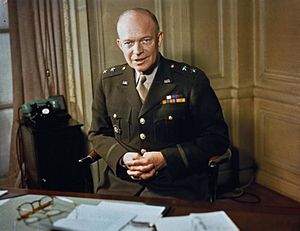
In November 1942, Eisenhower planned Operation Torch. This operation took place in Rock of Gibraltar. Eisenhower was the first non-British person to command Gibraltar in 200 years. Operation Torch involved about 65,000 American and British troops. They landed in North Africa. This was the first amphibious attack of World War II. It was also the first time U.S. troops fought against Nazi Germany. The French forces in North Africa signed a peace agreement with the Allies.
After the Axis forces in North Africa surrendered, Eisenhower led the successful invasion of Sicily. Once Mussolini, the Italian leader, was no longer in power, the Allies moved to mainland Italy. This was called Operation Avalanche.
President Roosevelt and British Prime Minister Churchill wanted Italy to surrender completely. While they argued with Eisenhower about this, the Germans in Italy grew stronger. This made the fighting harder. But the Allied forces still defeated them.
Supreme Allied Commander and D-Day
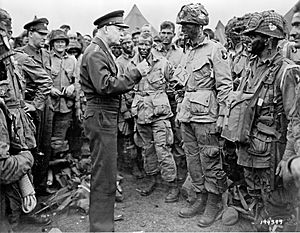
In December 1943, President Roosevelt chose Eisenhower to be the Supreme Allied Commander in Europe. He was also still the Commanding General of the European Theater of Operations. In these roles, he had to plan and carry out the Allied attack on the coast of Normandy in June 1944. The secret name for this attack was Operation Overlord.
On June 6, 1944, known as D-Day, the Allies landed on the beaches of Normandy. They came from a huge fleet of about 4,000 ships. Many soldiers were lost that day. Eisenhower made sure to visit every division involved in the invasion. He knew they and their families had suffered greatly. The Battle of Normandy continued until German forces left across the Seine River on August 30, 1944. This ended Operation Overlord.
Victory in Europe
After the coastal attack succeeded, Eisenhower kept control of the land battle plan. He managed the command and supply for many attacks through France and Germany. Eisenhower worked well with allies like Winston Churchill, Field Marshal Bernard Montgomery, and French General Charles de Gaulle. He had disagreements with Churchill and Montgomery about strategy. But these rarely harmed his relationships with them. He also became good friends with Soviet Marshal Zhukov.
Eisenhower showed great leadership and diplomacy skills. On December 20, 1944, he was promoted to General of the Army. This rank was equal to a Field Marshal in most European armies.
In December 1944, the Germans launched a surprise attack. This was at Ardennes, Belgium. Eisenhower moved his armies quickly. Better weather allowed the U.S. Air Force to help attack the Germans in 1945. This battle was called the Battle of the Bulge. German forces became weaker on both sides of Europe. The Soviet Red Army captured Berlin after a huge battle. The Germans finally surrendered on May 7, 1945.
After World War II
Military Governor and Army Chief of Staff
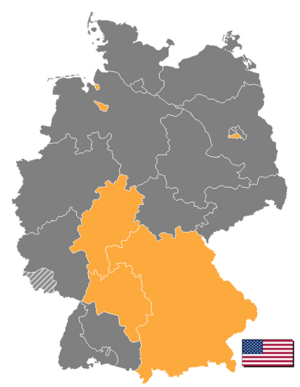
After Germany surrendered, it was divided into areas. These areas were controlled by the U.S., Britain, France, and the Soviet Union. Eisenhower became the Military Governor of the U.S. part of Germany.
In 1945, Eisenhower thought some people might try to deny the Holocaust. So, he ordered many photos and films to be taken. This was to prove that the Nazi death camps and the people who suffered there truly existed. He made sure camera crews documented the terrible things that happened. This evidence was used in the Nuremberg Trials. These trials punished the Nazis for their war crimes. Eisenhower also sent a lot of food and medical supplies to help German civilians. This showed that the German people were also victims of the Nazis.
In November 1945, Eisenhower returned to Washington. He became the Chief of Staff of the Army. His main job was to bring American troops home after the war. He did not like that the U.S. had used atomic bombs on Japan. He hoped for a peaceful relationship with the Soviet Union. He strongly supported the new United Nations.
Columbia University and NATO
In 1948, Eisenhower became President of Columbia University. This is a famous university in New York City. He also led the Council on Foreign Relations. This group discussed important social and political topics. He learned a lot about economics from these talks.
He also started the American Assembly at Columbia. He believed that schools should be more involved in discussing current problems. The American Assembly was a safe place for people to talk about these issues. In 1948, he also published his memoir, Crusade in Europe.
While at Columbia, he was asked to advise the U.S. Secretary of Defense. He helped combine the different parts of the armed services. In 1950, he became the Supreme Commander of the North Atlantic Treaty Organization (NATO). He was given command of NATO forces in Europe. Eisenhower retired from the Army on May 31, 1952. He remained president of Columbia University until January 20, 1953. On that day, he became the President of the United States.
Presidential Elections
Eisenhower was a Republican from Kansas. He used his nickname “Ike” in his campaign slogan: “I Like Ike.” He promised the American people that he would bring peace and prosperity. He won the presidency in a huge victory. He defeated Democrat Adlai Stevenson in both the 1952 and 1956 elections. He won many more votes than Stevenson in both elections.
Presidency (1953–1961)
Eisenhower understood how important it was to have a good relationship with the press. He thought they were a great way to talk directly to the American people. He held over 200 press conferences during his two terms as President.
Eisenhower achieved many things during his time as president:
- In 1953, he helped end the Korean War. He placed American soldiers at the border between North and South Korea. This helped keep the peace.
- He continued many programs started by previous presidents. These included the New Deal and Fair Deal programs. He also created the Department of Health, Education, and Welfare.
- On June 1, 1954, Eisenhower signed a law that changed Armistice Day to Veterans Day.
- By the end of 1954, military experts wanted him to use atomic weapons against communist China. But Eisenhower refused. He managed to keep the peace without attacking China.
- In 1956, Eisenhower created the "Eisenhower Doctrine." This was to stop the spread of communism. He said that any country threatened by another could ask the U.S. for help. He also allowed the Central Intelligence Agency (CIA) to run secret operations against communism.
- In 1956, he signed a bill to create the Intersate Highway System. Eisenhower believed these highways would help the economy. He also saw them as a way for the military to move faster if there was an attack.
- Eisenhower tried to reduce the tension between the U.S. and Russia during the Cold War.
- After Russia launched Sputnik in 1957, Eisenhower created NASA. This was a civilian space agency, started in October 1958. He also signed an important science education law. He improved relationships with American scientists.
- President Truman had started to end segregation in the military in 1948. But it was a slow process. President Eisenhower proposed the Civil Rights Act of 1957 and the Civil Rights Act of 1960. He signed these into law to help end segregation.
- On August 26, 1959, Eisenhower became the first President to fly on Air Force One. This was the new presidential plane.
- Alaska and Hawaii became states while "Ike" was President.
End of Presidency
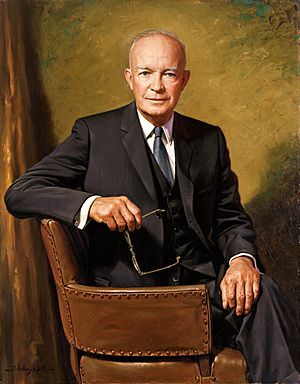
The 22nd Amendment to the U.S. Constitution was made official in 1951. It set a limit of two terms for a president. Eisenhower was the first U.S. President who could not run for a third term because of this law.
Eisenhower was also the first outgoing President to receive protection under the Former Presidents Act. This law allowed him to receive pay for the rest of his life. He also got staff provided by the government and Secret Service protection.
Eisenhower supported Richard Nixon to be the next President. He did not want John F. Kennedy (JFK) to win. However, Nixon lost to Kennedy by a small number of votes. Eisenhower was the oldest president at that time, at 70 years old. He was followed by the youngest elected president, 43-year-old JFK.
After his presidency, Congress made him a five-star general in the United States Army again.
Post-Presidency and Death
After his presidency, Eisenhower and Mamie moved to a farm near the battlefield at Gettysburg, Pennsylvania. In 1967, the Eisenhowers gave their Gettysburg farm to the National Park Service. They also had a retirement home in Palm Desert, California.
Eisenhower stayed somewhat involved in politics after being president. He supported Republican candidates. He was happy when his former vice president, Richard Nixon, was elected President in 1968.
On March 28, 1969, Eisenhower died in Washington, D.C. He was 78 years old. He died from heart failure. His body was moved to the Washington National Cathedral. Then it was taken to the United States Capitol, where people could pay their respects. On March 31, his funeral service was held at the National Cathedral.
Eisenhower was buried next to his son Doud. They are buried in a small chapel at the Eisenhower Presidential Library in Abilene, Kansas. His wife Mamie was buried next to him after she died in 1979.
Awards and Honors
Major Dwight D. Eisenhower graduated from the Army Industrial College in Washington, DC, in 1933. He later taught there. This school is now named after him.
Dwight D. Eisenhower Quotes
- "The world could be fixed of its problems if every child understood the necessity of their existence."
- "The history of free men is never written by chance but by choice - their choice."
- "What counts is not necessarily the size of the dog in the fight- it's the size of the fight in the dog."
- "The search for a scapegoat is the easiest of all hunting expeditions."
- "The supreme quality for leadership is unquestionably integrity. Without it, no real success is possible, no matter whether it is on a section gang, a football field, in an army, or in an office."
Interesting Facts About Dwight D. Eisenhower
- His first name was originally David. But his mother switched it to Dwight to avoid confusion with his father.
- Camp David is named after Eisenhower's grandson, David.
- He was best known for his military career. However, he never saw active combat himself.
- He was an expert in planning and logistics.
- Eisenhower did not want to use nuclear weapons on Japan. Truman did.
- Eisenhower said that racial discrimination was a national security issue. He saw that other countries might use it against the United States.
- One of his favorite hobbies was painting landscapes and portraits.
Images for kids
-
The Eisenhower family home in Abilene, Kansas
-
As president of Columbia, Eisenhower presents an honorary degree to Jawaharlal Nehru.
-
Eisenhower meeting with Egyptian President Gamal Abdel Nasser during Nasser's visit to United Nations in New York, September 1960
-
Eisenhower visits the Kingdom of Afghanistan and its king Mohammed Zahir Shah in Kabul.
-
Soviet Premier Nikita Khrushchev during his 11-day U.S. visit as guest of President Eisenhower, September 1959
-
President Eisenhower with Wernher von Braun, 1960
-
Spanish dictator Francisco Franco and Eisenhower in Madrid in 1959
-
Eisenhower signs the legislation that changes Armistice Day to Veterans Day, June 1, 1954
-
President John F. Kennedy meets with General Eisenhower at Camp David, April 22, 1961, three days after the failed Bay of Pigs Invasion
-
Eisenhower Interstate System sign south of San Antonio, Texas
-
Bronze statue of Eisenhower in the Capitol rotunda
-
Eisenhower speaks to the press at the 1964 Republican National Convention
See Also
 In Spanish: Dwight D. Eisenhower para niños
In Spanish: Dwight D. Eisenhower para niños


